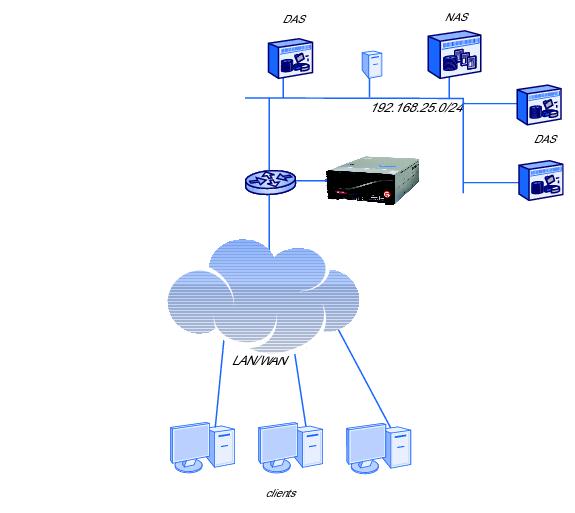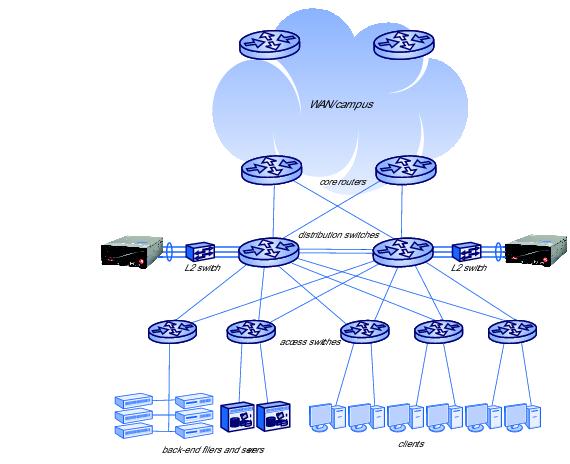Manual Chapter :
Introduction
Applies To:
Show Versions
ARX
- 6.3.0
Use this book after the ARX is installed, connected to the IP network, and serving clients. The platforms Hardware Installation manual explains how to install the ARX. You can set up basic networking through a GUI wizard, or work with the more-advanced CLI features described in ARX® CLI Network-Management Guide. The GUI provides wizards for configuring most of the storage features in the ARX; the ARX® CLI Storage-Management Guide provides procedures and best-practices for configuring all of them through the CLI.
The Adaptive Resource Switch (ARX®) is a highly available and scalable solution that brings resource awareness to a file storage infrastructure, and adapts these resources to meet the demands of users and applications in real time. The ARX provides a file-virtualization layer that aggregates the total capacity and performance of your file storage. A namespace provides location-independent, transparent mapping of user requests onto the appropriate storage resource. You can configure policies that the switch enforces for the placement, replication and migration of files. Through policy configuration, the ARX adapts to the real-time demands of users and applications. The ARX thereby serves as a resource proxy for the files and services behind it.
The Adaptive Resource Switch acts as an in-band file proxy for the Network File System (NFS) and Microsoft's Common Internet File System (CIFS) protocols.
Front-end services provide the file virtualization layer that masks the physical file storage from the user and application. The switch becomes the file access point, as opposed to the actual physical resource, providing file access through a namespace. Users and applications maintain a single consistent file path that is transparently mapped to the proper physical resource where the information resides.
Front-end services provide the file virtualization layer that masks the physical file storage from the user and application. The switch becomes the file access point, as opposed to the actual physical resource, providing file access through a namespace. Users and applications maintain a single consistent file path that is transparently mapped to the proper physical resource where the information resides.
The Adaptive Resource Switch provides policy-based resource switching. Through policy configuration, you can optimize the placement of files onto the appropriate storage resources and automatically adapt these resources based on user and application demand. The ARX performs file replication and migration based on performance, usage or other life-cycle characteristics, enabling you to implement a flexible file services strategy. Examples of policies include: migrating files to reclaim stranded capacity; migrating files across different tiers of storage based on access patterns and/or value; and replicating frequently accessed files for performance. The result is more efficient utilization and greater flexibility in file storage management.
You can connect multiple ARXes with a Resilient Overlay Network (RON), which can reside on top of any IP network. This provides a network for distributing and accessing file storage. ARXes can replicate storage to other switches in the same RON, updating the replicas periodically as the writable master files change. This is called a shadow copy, where a source volume on one switch periodically copies its files to one or more shadow volumes on other switches. Clients can access the shadow volumes at multiple geographic locations, independent to where the source volume resides.
This manual contains instructions for maintaining an ARX after it has been fully installed, it has been fully provisioned, and it has provided service to your clients. Other manuals explain installation and provisioning. The Hardware Installation Guide contains instructions to install the switch, set up its management IP, and prepare it for CLI provisioning. After a successful installation, a network engineer can then use the ARX Manager or the ARX® CLI Network-Management Guide to set up all networking parameters. Finally, a storage engineer can use the GUI wizards or the ARX® CLI Storage-Management Guide to aggregate storage and set up storage policies.
| 2. | backing up configuration data with show running-config and similar commands, |
this font represents screen input and output;
| bold text represents input, and |
| italic text appears for variable input or output. |
this font is used for command-syntax definitions, which use the same rules for bold and italic.
| [choice1 | choice2]* - an asterisk (*) means that you can choose none of them, or as many as desired (for example, choice1 choice2 chooses both); |
The Command-Line Interface (CLI) has its commands grouped into modes. Modes are structured as a tree with a single root, exec mode. This section summarizes the mode structure and explains some CLI conventions.
You can access all global commands (such as show commands) from exec mode, and you can use the enable command to enter priv-exec mode.
bstnA> enable
To enter cfg mode, use the config command:
bstnA# config
To enter gbl mode, use the global command:
bstnA# global
From any mode, use the exit command to return to its parent mode. From priv-exec mode, this command exits the CLI; to go from priv-exec mode back to exec mode, use the no enable command.
From any submode of cfg or gbl mode, you can return immediately to priv-exec mode by using the end command or pressing <Ctrl-z>.
bstnA(gbl)# namespace wwmed
bstnA(gbl-ns[wwmed])# volume /local
bstnA(gbl-ns[wwmed])# no volume /local
Many objects and configurations require you to enable them using the enable command before they can take effect. Likewise, many objects and configurations require you to first disable them using the no enable command before you can complete a related command or function. The no enable command does not remove an object; it only disables it until you re-enable it. The enable/no enable commands exist in many modes and submodes in the CLI.
bstnA(gbl)# namespace wwmed
bstnA(gbl-ns[wwmed])# enable
For the initial login, refer to the instructions for booting and configuring the switch in the appropriate Hardware Installation Guide.
Username: admin
Password: acopia
After you log into the CLI, use the config command to enter cfg mode:
SWITCH> enable
SWITCH# configure
To enter gbl mode, use the global command instead:
SWITCH> enable
SWITCH# global
The network filers all live on a class-C subnet at 192.168.25.x. These filers are called back-end filers, since they are the storage behind the front-end services of the ARX. The filers can be heterogeneous: NAS devices and file servers (possibly with additional DAS) need only support CIFS or NFS to be on the back end of the ARX.







